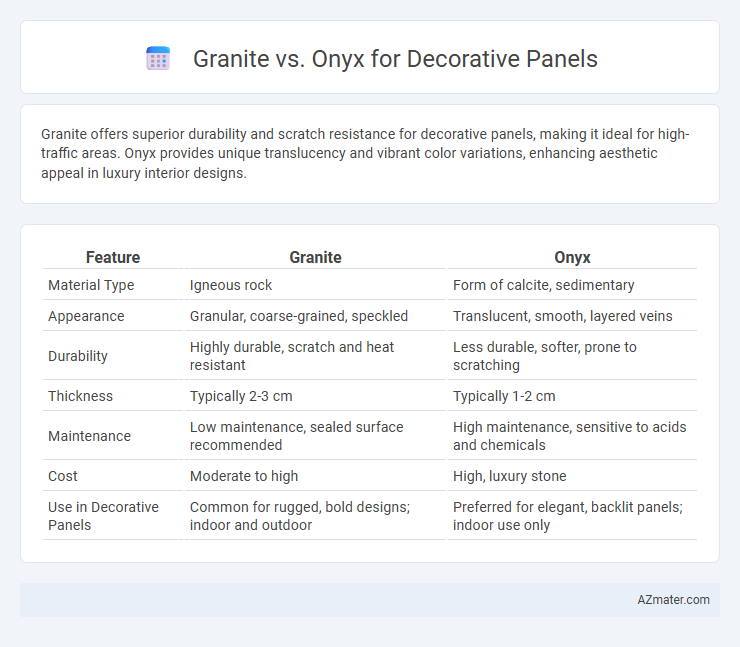Granite offers superior durability and scratch resistance for decorative panels, making it ideal for high-traffic areas. Onyx provides unique translucency and vibrant color variations, enhancing aesthetic appeal in luxury interior designs.
Table of Comparison
| Feature | Granite | Onyx |
|---|---|---|
| Material Type | Igneous rock | Form of calcite, sedimentary |
| Appearance | Granular, coarse-grained, speckled | Translucent, smooth, layered veins |
| Durability | Highly durable, scratch and heat resistant | Less durable, softer, prone to scratching |
| Thickness | Typically 2-3 cm | Typically 1-2 cm |
| Maintenance | Low maintenance, sealed surface recommended | High maintenance, sensitive to acids and chemicals |
| Cost | Moderate to high | High, luxury stone |
| Use in Decorative Panels | Common for rugged, bold designs; indoor and outdoor | Preferred for elegant, backlit panels; indoor use only |
Introduction to Granite and Onyx Decorative Panels
Granite decorative panels offer exceptional durability and a natural stone aesthetic with unique grain patterns and a wide color range, making them ideal for both indoor and outdoor applications. Onyx decorative panels are prized for their translucency and vibrant, intricate veining, often used for backlit installations to create dramatic, luxurious effects in interior design. Both materials provide distinct textures and visual appeal, with granite emphasizing robustness and onyx highlighting elegance and light diffusion.
Aesthetic Differences Between Granite and Onyx
Granite offers a coarse, granular pattern with a variety of earth tones, providing a natural, rugged aesthetic ideal for rustic or traditional decorative panels. Onyx features translucent properties with vibrant, swirling patterns and a glossy finish, making it a striking choice for luxurious and dramatic panels that highlight lighting effects. The aesthetic difference lies in granite's opaque, textured appearance versus onyx's smooth, luminous surface that brings depth and elegance to interior spaces.
Physical Properties and Strength Comparison
Granite offers exceptional hardness with a Mohs scale rating of 6-7, making it highly resistant to scratches and suitable for heavy-duty decorative panels. Onyx, with a lower hardness of 3-4, is more fragile and prone to chipping, but provides unique translucency and vibrant color variations. The compressive strength of granite typically exceeds 130 MPa, significantly higher than onyx's average of 70 MPa, making granite the preferred choice for durability and structural stability in decorative applications.
Color Variations and Visual Appeal
Granite offers a vast spectrum of earthy tones, speckles, and crystalline patterns, creating a natural, durable look ideal for decorative panels that require strength and subtle elegance. Onyx stands out with its translucent quality and vibrant color variations, ranging from warm ambers to deep greens and reds, delivering a striking visual appeal that enhances ambient lighting effects. While granite provides consistent and robust aesthetics, onyx brings dynamic luminosity and bold color contrasts, making each material uniquely suited to different design preferences.
Durability and Maintenance Needs
Granite offers superior durability for decorative panels due to its hardness and resistance to scratches, heat, and stains, making it ideal for high-traffic or functional areas. Onyx, while visually striking with its translucent appearance, is softer and more prone to scratching, chipping, and chemical damage, requiring careful maintenance and sealing to preserve its beauty. Maintenance of granite typically involves routine cleaning with mild soap and sealing every 1-3 years, whereas onyx demands more frequent sealing and gentle cleaning to prevent etching and discoloration.
Cost Comparison: Granite vs Onyx Panels
Granite panels typically cost between $40 to $100 per square foot, offering a durable and cost-effective option for decorative surfaces. Onyx panels, however, are priced higher, ranging from $70 to $150 per square foot due to their rarity and translucent aesthetic. The higher cost of onyx reflects its luxurious appearance and the specialized installation required, making granite a more budget-friendly choice for large-scale projects.
Installation Process and Complexity
Granite decorative panels require professional installation due to their heavy weight and need for precise cutting with diamond tools, making the process labor-intensive and time-consuming. Onyx panels are lighter and more fragile, demanding careful handling and specialized adhesive techniques to avoid cracking or damage during installation. Both materials benefit from experienced installers, but onyx demands higher precision to maintain its translucent properties and aesthetic appeal.
Suitability for Different Interior Spaces
Granite offers exceptional durability and resistance to scratches and heat, making it ideal for high-traffic areas such as kitchens and commercial spaces. Onyx, with its translucent and luxurious appearance, suits low-impact decorative applications like feature walls or accent panels in living rooms and bathrooms. Choosing between granite and onyx depends on the functional demands and aesthetic goals of the interior space.
Environmental Impact and Sustainability
Granite exhibits high durability and longevity, reducing the need for frequent replacements and minimizing environmental waste in decorative panel applications. Onyx, being a softer and more fragile material, often requires more maintenance and replacement, leading to higher resource consumption over time. Quarrying granite generally causes less ecological disruption than onyx extraction, making granite a more sustainable choice for environmentally conscious interior design projects.
Making the Right Choice: Granite or Onyx for Decorative Panels
Granite offers unmatched durability and resistance to scratches and stains, making it ideal for high-traffic decorative panels requiring long-term resilience. Onyx provides a unique, translucent aesthetic with striking natural patterns, perfect for accent pieces where visual impact and backlighting enhance design appeal. Selecting between granite and onyx depends on balancing functional durability against desired artistic elegance in your decorative panel application.

Infographic: Granite vs Onyx for Decorative Panel
 azmater.com
azmater.com